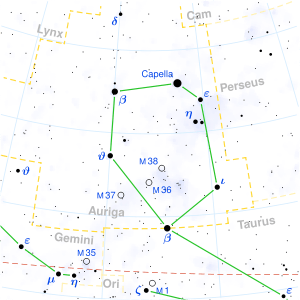RT Aurigae
RT Aurigae (RT Aur, 48 Aurigae) is a yellow supergiant variable star in the constellation Auriga, about 1,500 light years from Earth.
| Observation data Epoch J2000 Equinox J2000 | |
|---|---|
| Constellation | Auriga |
| Right ascension | 06h 28m 34.08751s[1] |
| Declination | +30° 29′ 34.92142″[1] |
| Apparent magnitude (V) | 5.75[2] (5.00 - 5.82[3]) |
| Characteristics | |
| Spectral type | F8Ib[4] (F4Ib - G4Ib[3]) |
| U−B color index | 0.5[5] |
| B−V color index | 0.74[2] |
| Variable type | δ Cep[3] |
| Astrometry | |
| Radial velocity (Rv) | 20.30[6] km/s |
| Proper motion (μ) | RA: 0.34 mas/yr Dec.: -14.95 mas/yr |
| Parallax (π) | -1.10 ± 1.41[1] mas |
| Distance | 473[7] pc |
| Absolute magnitude (MV) | -3.09[7] |
| Details | |
| Mass | 4.5[8] M☉ |
| Radius | 35.1[7] R☉ |
| Luminosity | 1,186[9] L☉ |
| Surface gravity (log g) | 1.5[2] cgs |
| Temperature | 6,151[9] K |
| Metallicity | 0.1[7] |
| Other designations | |
| Database references | |
| SIMBAD | data |
| Data sources: | |
| Hipparcos Catalogue, CCDM (2002), Bright Star Catalogue (5th rev. ed.) | |
RT Aurigae is an F to G type Classical Cepheid variable which varies from magnitude +5.00 to +5.82 with a period of 3.728309 days.[7] The variability was discovered in 1905.[10] It was quickly recognised as a member of the class of Cepheid variables, but their nature was not understood at that time. Radial velocity changes were detected corresponding to the brightness variations, but the idea that these were caused by stellar pulsations and temperature changes was largely dismissed in favour of orbital motions of a binary star.[11] More accurate observations eventually proved beyond doubt that the brightness variations were caused by pulsations in the atmospheres of the stars, with the stars being smallest and hottest near maximum brightness.[12]
RT Aurigae has been suspected to be a spectroscopic binary system, but this has not been confirmed.[13][8] The strongest evidence was found in 2013 using CHARA array optical interferometry. The companion would be 6.7 magnitudes fainter than the supergiant primary, cooler and fainter than an F0 main sequence star. The two stars are separated by 2.1 milli-arc seconds.[14]
References
- Van Leeuwen, F. (2007). "Validation of the new Hipparcos reduction". Astronomy and Astrophysics. 474 (2): 653–664. arXiv:0708.1752. Bibcode:2007A&A...474..653V. doi:10.1051/0004-6361:20078357.
- Soubiran, C.; Le Campion, J. -F.; Cayrel De Strobel, G.; Caillo, A. (2010). "The PASTEL catalogue of stellar parameters". Astronomy and Astrophysics. 515: A111. arXiv:1004.1069. Bibcode:2010A&A...515A.111S. doi:10.1051/0004-6361/201014247.
- Samus, N. N.; Durlevich, O. V.; et al. (2009). "VizieR Online Data Catalog: General Catalogue of Variable Stars (Samus+ 2007-2013)". VizieR On-line Data Catalog: B/GCVS. Originally Published in: 2009yCat....102025S. 1. Bibcode:2009yCat....102025S.
- Eggleton, P. P.; Tokovinin, A. A. (2008). "A catalogue of multiplicity among bright stellar systems". Monthly Notices of the Royal Astronomical Society. 389 (2): 869. arXiv:0806.2878. Bibcode:2008MNRAS.389..869E. doi:10.1111/j.1365-2966.2008.13596.x.
- Ducati, J. R. (2002). "VizieR Online Data Catalog: Catalogue of Stellar Photometry in Johnson's 11-color system". CDS/ADC Collection of Electronic Catalogues. 2237: 0. Bibcode:2002yCat.2237....0D.
- Gontcharov, G. A. (2006). "Pulkovo Compilation of Radial Velocities for 35 495 Hipparcos stars in a common system". Astronomy Letters. 32 (11): 759–771. arXiv:1606.08053. Bibcode:2006AstL...32..759G. doi:10.1134/S1063773706110065.
- Groenewegen, M. A. T. (2013). "Baade-Wesselink distances to Galactic and Magellanic Cloud Cepheids and the effect of metallicity". Astronomy & Astrophysics. 550: A70. arXiv:1212.5478. Bibcode:2013A&A...550A..70G. doi:10.1051/0004-6361/201220446.
- Turner, D. G.; Bryukhanov, I. S.; Balyuk, I. I.; Gain, A. M.; Grabovsky, R. A.; Grigorenko, V. D.; Klochko, I. V.; Kosa‐Kiss, A.; Kosinsky, A. S.; Kushmar, I. J.; Mamedov, V. T.; Narkevich, N. A.; Pogosyants, A. J.; Semenyuta, A. S.; Sergey, I. M.; Schukin, V. V.; Strigelsky, J. B.; Tamello, V. G.; Lane, D. J.; Majaess, D. J. (2007). "The Period Changes of the Cepheid RT Aurigae". Publications of the Astronomical Society of the Pacific. 119 (861): 1247. arXiv:0709.3085. Bibcode:2007PASP..119.1247T. doi:10.1086/523656.
- Turner, D. G. (2010). "The PL calibration for Milky Way Cepheids and its implications for the distance scale". Astrophysics and Space Science. 326 (2): 219–231. arXiv:0912.4864. Bibcode:2010Ap&SS.326..219T. doi:10.1007/s10509-009-0258-5.
- Turner, H. H. (1905). "New Variable 47.1905 Aurigae" (PDF). Astronomische Nachrichten. 168 (2): 29–30. Bibcode:1905AN....168...29T. doi:10.1002/asna.19051680209.
- Duncan, J. C. (1909). "The Orbits of the Cepheid Variables Y Sagittarii and RT Auriga; with a Discussion of the Possible Causes of this Type of Stellar Variation". Publications of the Astronomical Society of the Pacific. 21 (126): 119. Bibcode:1909PASP...21..119D. doi:10.1086/121905.
- Shapley, H. (1916). "The variations in spectral type of twenty Cepheid variables". Astrophysical Journal. 44: 273. Bibcode:1916ApJ....44..273S. doi:10.1086/142295.
- Evans, Nancy R. (1992). "A magnitude-limited survey of Cepheid companions in the ultraviolet". Astrophysical Journal. 384: 220. Bibcode:1992ApJ...384..220E. doi:10.1086/170865.
- Gallenne, A.; Mérand, A.; Kervella, P.; Monnier, J. D.; Schaefer, G. H.; Baron, F.; Breitfelder, J.; Le Bouquin, J. B.; Roettenbacher, R. M.; Gieren, W.; Pietrzyński, G.; McAlister, H.; Ten Brummelaar, T.; Sturmann, J.; Sturmann, L.; Turner, N.; Ridgway, S.; Kraus, S. (2015). "Robust high-contrast companion detection from interferometric observations. The CANDID algorithm and an application to six binary Cepheids". Astronomy & Astrophysics. 579: A68. arXiv:1505.02715. Bibcode:2015A&A...579A..68G. doi:10.1051/0004-6361/201525917.
